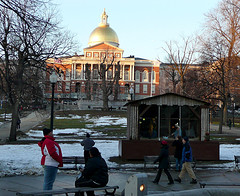 Religious holidays are not only enjoyable, but controversial. For decades American citizens have debated whether towns may erect nativity scenes on public property. We now have a body of law that governs this issue.
Religious holidays are not only enjoyable, but controversial. For decades American citizens have debated whether towns may erect nativity scenes on public property. We now have a body of law that governs this issue.
The basis of the debate is the First Amendment of the Constitution, which states that Congress shall not make any law regarding an “establishment of religion.” It says Congress and does not prohibit states or towns from creating an official church. It was only the twentieth century that the First Amendment was reinterpreted to mean that government in general cannot create an established religion.
Another trend in the twentieth century was to heighten the level of sensitivity to the meaning of “establishment.” Originally, this term referred to an official church, like the Church of England. In modern times, however, the Supreme Court understands “establishment” to mean something like “endorsement.” That is, the government must not endorse any particular religion in any way. This is a higher standard because it means that even in the absence of an official state religion, the state would violate the Constitution simply by committing particular acts that support a religion.
We can now see why nativity scenes are a problem. If a town sets up a religious display on public land, or allows a private group to set up a religious display, the town appears to endorse that religion. The current understanding is that this is illegal, unless the town permits all religious groups to erect their symbols in the common area. Religious display on public property is legal, provided it has a pluralistic character and does not highlight one religion above others.
So much for the law. What does it reveal about our culture? There are three problems with our approach.
The first is that in spite of the commitment to pluralism, some religions come out ahead of others: namely, those that have holiday symbols at all. Some religions don’t have much going on around Christmas time, or don’t place importance on symbols. So the result is that the public space gets filled with the same religious icons (nativity scenes, menorahs) over and over again. I am not sure I would call this real pluralism.
The next problem is that Christianity is always a privileged force in our society. The fact that school holidays take place around Christmas is a prime example. The idea that our government is entirely neutral with respect to religion is undermined by how work and school holidays coincide with the needs of Christian observance.
At this point, the reader may think that I am about to advocate a militantly secular reform of our society. But the opposite is the case. Speaking as someone who is not a Christian, I am not against Christian symbols during Christmas time on public land—even when not accompanied by Jewish and other symbols. As long as the Christian symbols are not part of a plan to kill or persecute religious minorities, I do not feel anxiety. I am not offended by Christian symbols for the simple reason that I choose not to be offended by something that is so powerless to harm me. I do not think that a Christian symbol, temporarily erected in a park, is intrinsically more offensive or harmful than many other symbols that are permanent, such as a McDonald’s arch or a sexually lurid billboard.
I personally feel that it is a social advantage not to be Christian in America. We speak so much of the advantages of being in the majority and not the advantages of being in a minority (in my case, being Jewish). The sense of being excluded and different can be a positive experience. Non-Christian children gain a sense of distance from social customs: they become critical observers. The really creative people are the ones who feel like outsiders. If Christians wish to make me an outsider without physically or economically harming me, I can only thank them for making it so easy for me to raise my family in an atmosphere of non-conformity.
I often discuss Christmas and its symbols with my children with a kind of sociological detachment. Clearly, much of the creativity of minorities in our country stems from their lack of involvement in prevailing forms. As long as Christian symbols remain just symbols and not part of an effort to persecute me, I can enjoy them—-even more than my Christian neighbors. Happy holidays!
Photo by Lorianne DiSabato, accessed through Creative Commons


